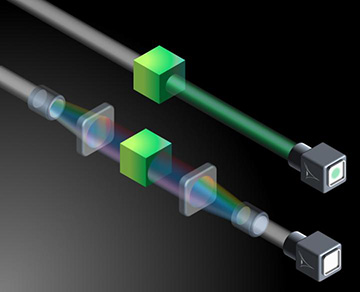
Top: A broadband wave illuminates an object, which reflects green light, making the object detectable by an observer or instrument, such as a camera, monitoring the wave. Bottom: A spectral invisibility cloak transforms the blocked color (green) into other colors of the wave's spectrum. The wave propagates unaltered through the object without “seeing its color,” and the cloak subsequently reverses the previous transformation, making the object invisible to the observer. [Image: Luis Romero Cortés and José Azaña / INRS]
Despite many advances over the past decade, realizing the dream of a true “invisibility cloak” keeps hitting a roadblock: broadband illumination. Researchers at a Canadian laboratory have proposed a new concept that reversibly transforms the energy spectrum of the broadband illumination to conceal an object from detection (Optica, doi: 10.1364/OPTICA.5.000779).
Altering light–object interaction
The spectral invisibility cloaking technique, as described by José Azaña and his colleagues at the Institut National de la Recherche Scientifique (INRS) in Montreal, alters the interaction between light waves and the object being illuminated. Although the team demonstrated the concept with near-infrared light passing in one direction through an optical filter, the researchers say that the methodology could be extended to large spatial regions, multiple illumination directions and different regions of the electromagnetic spectrum.
In the simplest theoretical case, a given object under broadband illumination reflects or transmits certain frequencies of light, which are then seen by the observer or detector. The INRS group's cloak redistributes the incoming light energy toward other regions of the electromagnetic spectrum that do not interact with the cloaked object. After the non-interacting waves pass through the object, they go through the opposite transformational process to return to their original phase and amplitude.
Cloaking an optical filter
For their proof-of-concept demonstration, the INRS researchers used linear phase transformations—based mathematically on a type of near-field diffraction known as the Talbot effect—to manipulate the light from a near-infrared mode-locked laser with a bandwidth of roughly 500 GHz. (By contrast, the bandwidth of the entire visible region is more than 300 THz.) The “cloak” on either side of the disguised optical filter consisted of single-mode fibers and electro-optic phase modulators controlled by a radio-frequency synthesizer. As expected, the cloak created frequency gaps to hide the filter.
The authors say that the spectral cloaking technique could be modified for different types of waves, from acoustic waves to matter waves and even certain quantum interactions.
